
Have you ever wondered how it’s done–how a lone cowboy doctors cattle in the middle of thousands of acres without a corral or squeeze chute in sight? You can’t see them from the road but working cowboys are alive and well in Western Canada. They still work cows the best and least-stressful way; with a horse, a rope and often a good dog.
Special thanks to Doug Peterson, a lease rider on a community pasture in the Eastern Irrigation District (EID) around Brooks, Alta., who let his wife Linda photograph him, his horse Wilbur and his dog Lil Miss doing their job; caring for patron’s cattle. Each working cowboy might do things a bit differently for any number of reasons, including terrain, and with that in mind, this is what works for Doug.
One of the main components of a working cowboy’s job is recognizing and treating sick cattle. To treat this calf, he “sneak-roped” it by the head, not the usual catch, but the long grass made it hard to rope the preferred hind leg. His dog is working to focus the calf’s attention away from the cowboy.

He quietly manoeuvres the calf to a better spot and then catches the hind leg with a second rope. He releases the neck rope and dallies (takes wraps around the horn) the second rope. Then he waits to make sure everything is calm. Because closer is safer for all involved, he releases his dallies, quietly rides up a step or two and dallies again.
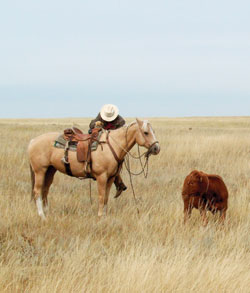
Patience is good and again he waits to make sure everything is calm before dismounting.
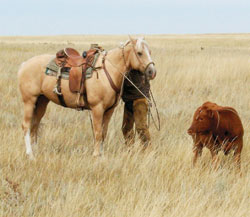
Doug takes the coils of the rope from his left hand and, while still dallied, ties off by running the rope under the horses’ neck, over the rope running to the calf’s hind foot and then back to the horn. He ties off with a couple of half-hitches. This works to keep his horse facing the calf.
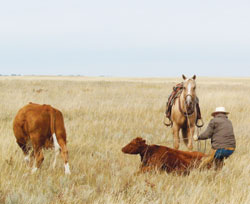
Using the neck loop and the calf’s tail for leverage, the approximately 400 lb. bovine is “tailed down” (pulled off-balance) so it lies down and is in a position so Doug can tie together the calf’s two top legs.
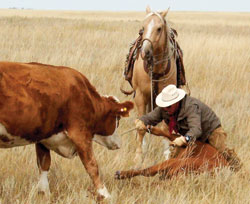
The back leg is scooped up and pushed forward toward the top front leg and they’re tied together with a leg rope. This is not like tie-down roping at rodeos where three legs are tied with a stiff piggin’ string. A leg rope is soft; Doug makes his from 6–8 feet of old, worn out lariat from which one strand has been removed.
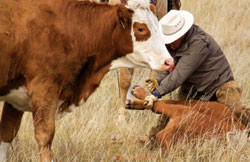
The legs are tied by crossing the top front leg over the top bottom leg and wrapping the leg rope around moreonce, with a half knot at the top between wraps than once ended with a simple square knot on top. A cowboy can make this all look easy, until you consider the proximity of a 1,200–1,800 lb. concerned mother. It takes a lot of nerve to do this eye level with a cow, alone.
(This mother turned out to be a pretty nice cow, but they aren’t all like that.)

With everything under control he heads back to his horse to get the calf’s medicine from the cantle pack. Even the dog, which was wisely waiting away out before, has been allowed to come in to lay down by the horse.
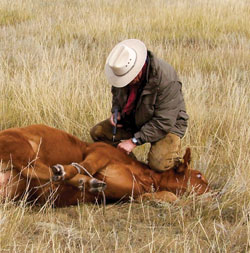
Doug places his knee on the calf’s neck to keep him still and injects the medication in the small, fleshy triangular spot just ahead of the calf’s shoulder.
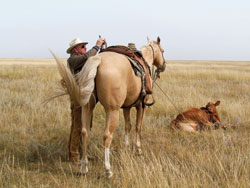
The syringe and medicine is safely stored back in the cantle pack and then the calf is untied; by first releasing the heel loop and then untying his legs. The calf is free to wander back to his waiting mother, treated and unstressed.
















